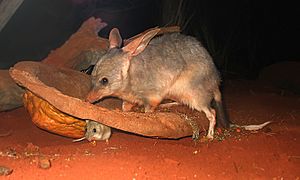Bilby facts for kids
Quick facts for kids Bilbies |
|
|---|---|
 |
|
| Scientific classification | |
| Kingdom: | |
| Phylum: | |
| Class: | |
| Infraclass: | |
| Order: | |
| Family: |
Thylacomyidae
Bensley, 1903
|
| Genus: |
Macrotis
Reid, 1837
|
| Species | |
The bilby (also known as the rabbit-eared bandicoot) is a rabbit-like marsupial. It lives in deserts, dry forests, dry grasslands, and dry shrubby areas in Australia. The bilby's pouch faces backwards. These big-eared, burrowing mammals are in danger of extinction.
The bilby, like all bandicoots, is a nocturnal animal (most active at night). Digging with its strong, clawed feet, this solitary mammal excavates long, complex burrows. Its underground dens are up to 5 feet (1.5 m) long.
At Easter, chocolate Easter Bilbies are sold as an Australian alternative to the Easter Bunny. Money raised from the sale of the bilby shaped chocolate is used to fund protection for the bilby.
Contents
Description
Bilbies have the characteristic long bandicoot muzzle and very big ears that radiate heat. They are about 29–55 cm (11–22 in) long. Compared to bandicoots, they have a longer tail, bigger ears, and softer, silky fur. The size of their ears allows them to have better hearing. They are nocturnal omnivores that do not need to drink water, as they obtain their moisture from food, which includes insects and their larvae, seeds, spiders, bulbs, fruit, fungi, and very small animals. Most food is found by digging or scratching in the soil, and using their very long tongues.
Unlike bandicoots, they are excellent burrowers and build extensive tunnel systems with their strong forelimbs and well-developed claws. A bilby typically makes a number of burrows within its home range, up to about a dozen, and moves between them, using them for shelter both from predators and the heat of the day. The female bilby's pouch faces backwards, which prevents the pouch from getting filled with dirt while she is digging.
Bilbies have a short gestation of about 12–14 days, one of the shortest among mammals.
Conservation

Bilbies are slowly becoming endangered because of habitat loss and change, and competition with other animals. There is a national recovery plan being developed for saving them. This program includes captive breeding, monitoring populations, and reestablishing bilbies where they once lived. There have been reasonably successful moves to popularise the bilby as a native alternative to the Easter Bunny by selling chocolate Easter Bilbies (sometimes with a portion of the profits going to bilby protection and research). Reintroduction efforts have begun, with a successful reintroduction into the Arid Recovery Reserve in South Australia in 2000, and plans are underway for a reintroduction into Currawinya National Park in Queensland, where there was success with six bilbies released into the feral-free sanctuary in early February 2006.
Successful reintroductions have also occurred on the Peron Peninsula in Western Australia as a part of Western Shield. Successful reintroductions have also occurred on other conservation lands, including islands and the Australian Wildlife Conservancy's Scotia and Yookamurra Sanctuaries. There is a highly successful bilby breeding program at Kanyana Wildlife Rehabilitation Centre near Perth, Western Australia.
Images for kids
See also
 In Spanish: Macrotis para niños
In Spanish: Macrotis para niños


